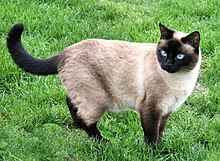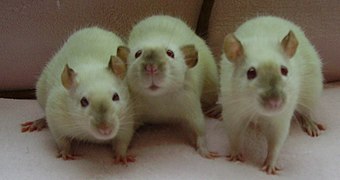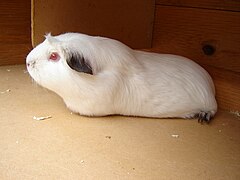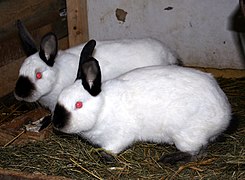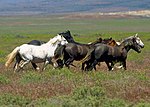
A bicolor cat is a cat with white fur combined with fur of some other color, for example, solid black, tabby, or colorpointed. There are various patterns of a bicolor cat. The coat patterns range from the Van-patterned, which has color on the tail and crown of the head, to a solid color with a throat locket or medallion. Bicolor coats are found in many cat breeds and are in domestic longhair and domestic shorthair cats.

Roan is a coat color found in many animals, including horses, cattle, antelope, cats and dogs. It is defined generally as an even mixture of white and pigmented hairs that do not "gray out" or fade as the animal ages. There are a variety of genetic conditions which produce the colors described as "roan" in various species.

Palomino is a genetic color in horses, consisting of a gold coat and white mane and tail; the degree of whiteness can vary from bright white to yellow. The palomino color derived from the inter-breeding of Spanish horses with those from the United States. Genetically, the palomino color is created by a single allele of a dilution gene called the cream gene working on a "red" (chestnut) base coat. Palomino is created by a genetic mechanism of incomplete dominance, hence it is not considered true-breeding. However, most color breed registries that record palomino horses were founded before equine coat color genetics were understood as well as they are today, therefore the standard definition of a palomino is based on the visible coat color, not heritability nor the underlying presence of the dilution gene.

Cat coat genetics determine the coloration, pattern, length, and texture of feline fur. The variations among cat coats are physical properties and should not be confused with cat breeds. A cat may display the coat of a certain breed without actually being that breed. For example, a Neva Masquerade could wear point coloration, the stereotypical coat of a Siamese.
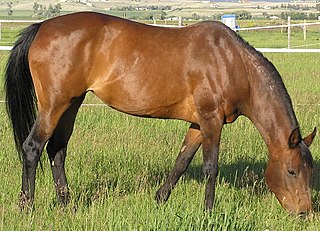
Bay is a hair coat color of horses, characterized by a reddish-brown or brown body color with a black point coloration on the mane, tail, ear edges, and lower legs. Bay is one of the most common coat colors in many horse breeds.

Buckskin is a colour of horse. Buckskins coloring is a hair coat color referring to a color that resembles certain shades of tanned deerskin. Similar colors in some breeds of dogs are also called buckskin. The horse has a tan or gold colored coat with black points. Buckskin occurs as a result of the cream dilution gene acting on a bay horse. Therefore, a buckskin has the Extension, or "black base coat" (E) gene, the agouti gene (A) gene, which restricts the black base coat to the points, and one copy of the cream gene (CCr), which lightens the red/brown color of the bay coat to a tan/gold.
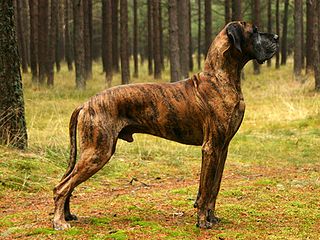
Brindle is a coat coloring pattern in animals, particularly dogs, cattle, guinea pigs, cats, and, rarely, horses. It is sometimes described as "tiger-striped", although the brindle pattern is more subtle than that of a tiger's coat.

The silver or silver dapple (Z) gene is a dilution gene that affects the black base coat color and is associated with Multiple Congenital Ocular Abnormalities. It will typically dilute a black mane and tail to a silvery gray or flaxen color, and a black body to a chocolaty brown, sometimes with dapples. It is responsible for a group of coat colors in horses called "silver dapple" in the west, or "taffy" in Australia. The most common colors in this category are black silver and bay silver, referring to the respective underlying coat color.

The dun gene is a dilution gene that affects both red and black pigments in the coat color of a horse. The dun gene lightens most of the body while leaving the mane, tail, legs, and primitive markings the shade of the undiluted base coat color. A dun horse always has a dark dorsal stripe down the middle of its back, usually has a darker face and legs, and may have transverse striping across the shoulders or horizontal striping on the back of the forelegs. Body color depends on the underlying coat color genetics. A classic "bay dun" is a gray-gold or tan, characterized by a body color ranging from sandy yellow to reddish brown. Duns with a chestnut base may appear a light tan shade, and those with black base coloration are a smoky gray. Manes, tails, primitive markings, and other dark areas are usually the shade of the undiluted base coat color. The dun gene may interact with all other coat color alleles.

The Colorpoint Shorthair is a variety of Siamese cat. The only major registries to recognise them are the Cat Fanciers' Association (CFA) and the World Cat Federation (WCF). This breed was established from breeding American Shorthairs with the Siamese to produce different point colors, beyond the four standard Siamese colors.

Grullo or grulla is a color of horses in the dun family, characterized by tan-gray or mouse-colored hairs on the body, often with shoulder and dorsal stripes and black barring on the lower legs. The genotype for grulla horses is a black base with dun dilution. In this coloration, each individual hair is mouse-colored, unlike a roan, which is composed of a mixture of dark and light hairs. The several shades of grulla are informally referred to with a variety of terms, including black dun, blue dun, slate grulla, silver grulla or light grulla, silver dun, or lobo dun. Silver grulla may also refer to a grulla horse with silver dapple, regardless of shade.

Chestnut is a hair coat color of horses consisting of a reddish-to-brown coat with a mane and tail the same or lighter in color than the coat. Chestnut is characterized by the absolute absence of true black hairs. It is one of the most common horse coat colors, seen in almost every breed of horse.

Horses exhibit a diverse array of coat colors and distinctive markings. A specialized vocabulary has evolved to describe them.

Primitive markings are a group of hair coat markings and qualities seen in several equine species, including horses, donkeys, and asses. In horses, they are associated with primitive breeds, though not limited to such breeds. The markings are particularly associated with the dun coat color family. All dun horses possess at least the dorsal stripe, but the presence of the other primitive markings varies. Other common markings may include horizontal striping on the legs, transverse striping across the shoulders, and lighter guard hairs along the edges of a dark mane and tail.

Pangaré is a coat trait found in some horses that features pale hair around the eyes, muzzle, and underside of the body. These pale areas can extend up to the flanks, throat and chest, behind the elbows, in front of the stifle, and up the buttock. Animals with the pangaré trait are sometimes called "mealy" or "light-pointed". The color of these lighter areas depends on the underlying color and ranges from off-white to light tan. This type of coloration is most often found in breeds such as the Fjord horse, Exmoor Pony, and Haflinger. Wild equids like the Przewalski's horse, onager, African wild ass, kiang as well as the domestic donkey exhibit pangaré as a rule. Pangaré is thought to be a type of protective countershading. Horse foals are often born with "foal pangaré" or light points, especially over black haired areas, which they lose when they shed their foal coats.
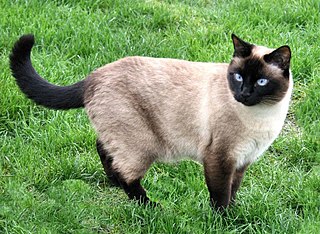
Acromelanism is a genetic condition that results in pigmentation being affected by temperature. It results in point coloration where the extremities of an animal are a different colour to the rest of the body. It is commonly known for the coloration of Siamese and related breeds of cat, but can be found in many other species including dogs, rabbits, rats, mice, guinea pigs, minks, and gerbils. It is a specific type of point coloration.

Seal brown is a hair coat color of horses characterized by a near-black body color; with black points, the mane, tail and legs; but also reddish or tan areas around the eyes, muzzle, behind the elbow and in front of the stifle. The term is not to be confused with "brown", which is used by some breed registries to refer to either a seal brown horse or to a dark bay without the additional characteristics of seal brown.

Flaxen is a genetic trait in which the mane and tail of chestnut-colored horses are noticeably lighter than the body coat color, often a golden blonde shade. Manes and tails can also be a mixture of darker and lighter hairs. Certain horse breeds such as the Haflinger carry flaxen chestnut coloration as a breed trait. It is seen in chestnut-colored animals of other horse breeds that may not be exclusively chestnut.
The agouti gene, the Agouti-signaling protein (ASIP) is responsible for variations in color in many species. Agouti works with extension to regulate the color of melanin which is produced in hairs. The agouti protein causes red to yellow pheomelanin to be produced, while the competing molecule α-MSH signals production of brown to black eumelanin. In wildtype mice, alternating cycles of agouti and α-MSH production cause agouti coloration. Each hair has bands of yellow which grew during agouti production, and black which grew during α-MSH production. Wildtype mice also have light-colored bellies. The hairs there are a creamy color the whole length because the agouti protein was produced the whole time the hairs were growing.
